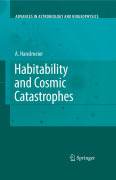
The solar system has a rather well-known history. Looking at the present situation, one might get the impression that it was a rather stable and well-defined system: the orbits of the planets appear to be stable, climate and atmospheres on the planets have been determined, the risk of collision with other bodies (comets, asteroids, meteorites) seems to be small. However it is known today that the evolution of life on Earth was neither a steady progression nor uniform. There were several periods of mass extinction. These catastrophic eventsplayed a crucial role in the rise of new species. Events of astrophysical origin include: Asteroid impacts - Major solar variability (space weather) - Nearby supernovae - The passage of the solar system through dense interstellar clouds. Catastrophic cosmic events of this type appear in the range of some 100 million years. The author discusses whether and how such events could have occurred in the recently found extrasolar planetary systems. Intermediate student’s level treating concisely The astrophysical aspects of habitabilty of planetsThe influence of cosmic catastrophies on evolution With introductory chapterson biological and chemical properties of life Topic of high public interest INDICE: Habitable Zones.- Properties and Environments of Life.- Stars and Galaxies.- Planetary Systems.- Catastrophes in our Solar System?- Catastrophesin Extrasolar Planetary Systems?- The Solar Neighborhood.- The Search for Extraterrestrial Life.- Appendix.
- ISBN: 978-3-540-76944-6
- Editorial: Springer
- Encuadernacion: Cartoné
- Páginas: 270
- Fecha Publicación: 01/11/2008
- Nº Volúmenes: 1
- Idioma: Inglés
